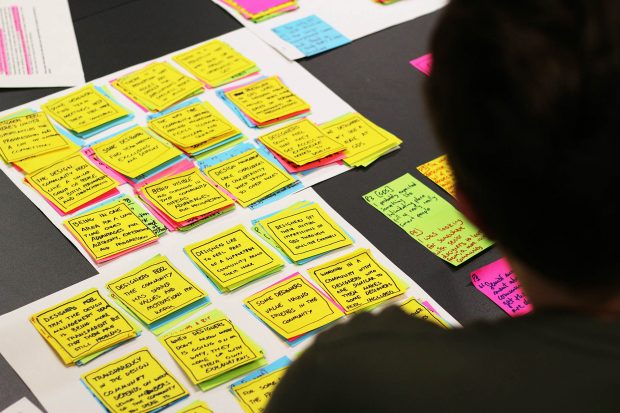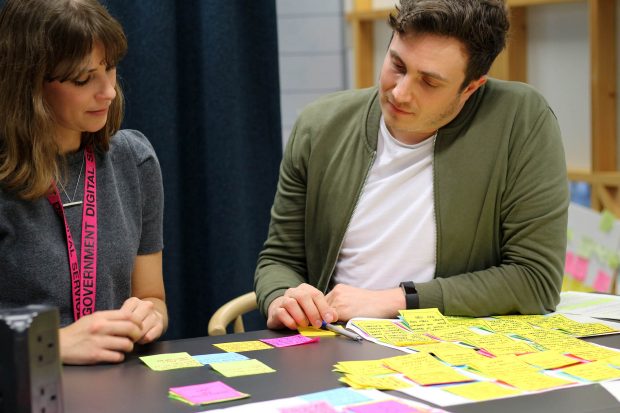
The GDS design community is currently working to improve the equity of our team. As part of this, the community is taking steps like running a mentoring scheme, going to schools to talk about design, and improving our recruitment process. Clara and Harry have recently blogged about this.
We also wanted to look at inclusion and exclusion in the design community by taking a user-centered approach. We wanted to understand the current experience of designers and how it affected their quality of life at work.
There’s no point hiring a more diverse team if the new designers don’t have an equitable, safe, and inclusive workplace to come in to – in fact that can do real harm.
We took a user-centred approach as we didn’t want to bring in our own biases and perceptions about the design community. We started by conducting user research.
What we did
We interviewed 8 designers from the GDS design community. To make sure that participants were safe, someone from outside the community conducted the research and took notes, and we didn’t make voice or video recordings. To protect privacy we anonymised the transcripts, and let participants know that they could review and edit their transcript before we started analysing them.
We ran 2 analysis sessions with the design team equity working group. This is a group of designers who are working on various things to improve the equity in our team. We meet up every 2 weeks to check on progress, and discuss ideas and problems.
During these sessions we looked at the transcripts, pulled out quotes, and carried out an initial affinity mapping. This included involving some of our participants in the analysis. We did this to follow principles of trauma-informed research by giving participants more ownership over their experiences, and the outcomes of the research. After that, we held 3 smaller sessions to synthesise and write findings.
There were some limitations:
- it’s a small community, where everybody knows each other – this made it difficult to fully anonymise everything, which is why it was important to let participants review their transcripts afterwards
- we tried to make the interviews as safe and comfortable as possible, but this can be a sensitive and emotional topic, and it was important to check in with participants afterwards
- we can only learn so much about our community from the people already working here – as we improve the equity of the community and hire from more underrepresented backgrounds, it will be important to keep looking at how the community experience is for everyone

What we found
We’ve focused on understanding the things that exclude designers, so that this research could be used to inform improvements, and to help us to become aware of these as a community:
- designers have a perception that others in the design community have similar backgrounds, personalities and characteristics
- some designers feel excluded because they feel they are not like other designers
- designers who feel excluded from the community feel less able to communicate safely with the community
- there is a perception that you need to be outgoing and visible in design in order to get opportunities for progression or development
- decisions on moves are often made based on personal relationships and preconceptions
- there is a perception that who your line manager is affects your opportunities for moves, development, and progression
The overall insight from this research was that as a result of these factors, when people feel excluded in the design community, this negatively impacts them in every area of their work experience.
Outcomes
We know we are not a diverse and representative community and we want to do better. We need safe and inclusive spaces and practices to allow equity in opportunities, development, and progression.
If we want to bring people from more diverse backgrounds to join the design team, and we have an environment which is cliquey, homogenous, and in which some already feel excluded, we risk giving them a bad experience at GDS. We don’t want that.
Some of the things that the community have done since this research, to try to improve the problems we found above.
First, we’ve used this research to inform the creation of a new onboarding process for designers at GDS.
Second, we’ve made changes to how we run design team meetings, including doing updates over Slack, sending out a weekly team email and trying different meeting formats like lean coffee and deep dives into a piece of work.
Third, we’ve hosted 3 UCD career events for people from under-represented groups in design. With these, we aim to answer some of the questions people have about working at and getting a job at GDS, give people the confidence to apply, connect candidates with people who work at GDS to chat further, and to help GDS understand the barriers to working at GDS for under-represented groups.
Fourth, we’ve made changes to how line management and coaching in the design team at GDS works, to make sure our designers, particularly our new designers, are supported by multiple other designers and have multiple routes to visibility in the management team.
Fifth, we’ve tried to make decision-making in the design community more transparent, by consulting designers more about their ideas, preferences, and needs; talking more openly about what the design management team is working on; and challenging decision-making processes and assumptions in how designers are managed.
Next steps
Because we are not diverse and representative enough today, we need to find a way to get input from people from underrepresented backgrounds whilst avoiding putting pressure on them. If not, we risk making changes which only benefit more privileged groups.
We still have a long way to go to make this better.
We’d love to hear your feedback, suggestions, thoughts or comments on this work, or to hear how you’re improving equity in your teams and organisations. Please let us know in the comments below.
